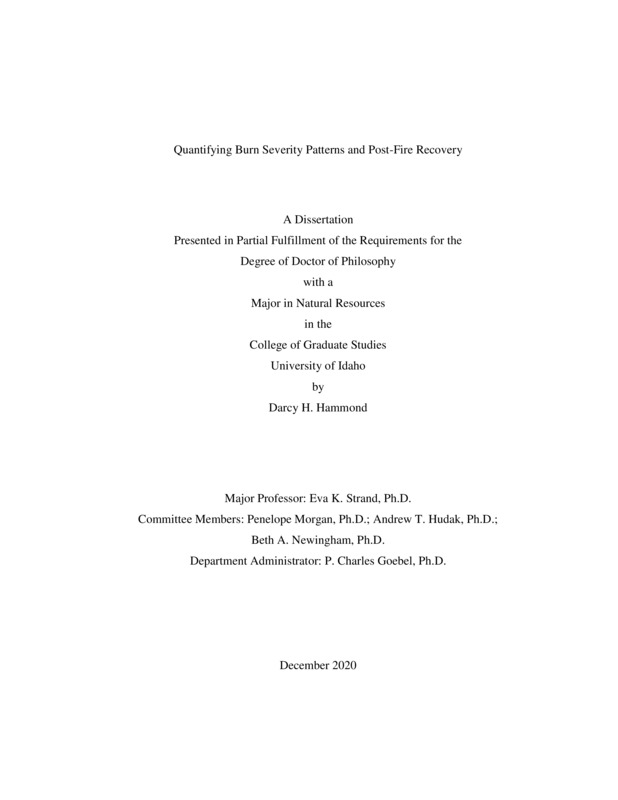Quantifying Burn Severity Patterns and Post-Fire Recovery
Hammond, Darcy H. (2020-12). Quantifying Burn Severity Patterns and Post-Fire Recovery. Theses and Dissertations Collection, University of Idaho Library Digital Collections. https://www.lib.uidaho.edu/digital/etd/items/hammond_idaho_0089e_12027.html
- Title:
- Quantifying Burn Severity Patterns and Post-Fire Recovery
- Author:
- Hammond, Darcy H
- ORCID:
- 0000-0003-3200-0833
- Date:
- 2020-12
- Program:
- Natural Resources
- Subject Category:
- Natural resource management; Forestry
- Abstract:
-
Fire plays an important role in shaping landscape patterns and ecological processes in many ecosystems across western North America. Burn severity is a primary measure of the ecological change caused by fire and differing levels of burn severity can in turn result from the interaction of landscape patterns, ecological processes that have created differing fuel loads and continuity, and abiotic factors such as climate and slope. Understanding how burn severity impacts ecosystem recovery post-fire can therefore inform both future recovery and management planning but also the resulting landscape patterns and processes that can influence future fires. This dissertation examined how burn severity and spatial patterns of differing burn severity levels impacted long-term (9-15 years post-fire) ecological processes in ponderosa pine (Pinus ponderosa) and boreal spruce forests (Picea glauca/Picea mariana). Specifically, the chapters addressed 1) how two contrasting landscape models derived from high resolution satellite imagery captured burn severity patterns in a ponderosa pine forest and how those patterns related to post-fire processes (distance to live tree, seedling density, understory species richness) on the Egley Fire Complex (OR); 2) how burn severity and associated biotic and abiotic factors (e.g., tree density, understory green cover, soil cover, downed woody fuel) interacted with climate and site factors (e.g., elevation, soil productivity) to influence ponderosa pine seedling density and height growth on three fires across the western contiguous US (Jasper Fire [SD], Hayman Fire [CO], Egley Fire Complex [OR]); 3) how burn severity level, as indicated by a remote sensing index, related to understory species community assemblage and vegetation conditions (e.g., overstory density, surface cover, downed woody fuel load) 12 years after the Taylor Fire Complex (AK) in boreal spruce forest. Examination of high resolution satellite imagery captured shortly following containment of the Egley Fire Complex showed that tree crowns were driving the spatial variability of the landscape, and that both a continuous (gradient) and a categorical (patch-matrix) landscape model produced metrics that related strongly to distance to live tree. Neither model, however, produced metrics that related strongly to seedling density or understory species richness, indicating that potentially even analysis of fine-scale imagery (0.6 m) does not meaningfully capture microsite variation that explains these post-fire processes. Across three ponderosa pine fires, our model showed that burn severity and related factors (percent soil surface cover, fine woody fuel load, and basal area of dead trees) interact to influence the density of seedlings. In contrast, the height growth of those seedlings was influenced by soil productivity, basal area of live trees, and climate (fall degree-days above 5°C and winter evapotranspiration). Finally, 12 years following the Taylor Fire Complex in boreal spruce forest we found that burn severity, as indicated by Landsat-derived delta Normalized Burn Ratio, still significantly impacted tree density, tall shrub cover, and downed woody fuel load. Burn severity also related to significant differences in understory plant community species assemblage and richness, in association with elevation and aspect. Overall our research finds that long-term effects of burn severity continue to be present in these ecosystems and that these effects influence important post-fire processes. This research presents the first use of the gradient landscape model to characterize burn severity patterns and their relationship to ecological processes following fire in ponderosa pine. We further highlight the potential for differing factors to influence ponderosa pine seedling density vs. height growth and the importance of considering height growth when examining post-fire recovery. Finally we show that burn severity inferred from satellite imagery has long-term impacts on vegetation and woody fuels in boreal spruce forest.
- Description:
- doctoral, Ph.D., Natural Resources -- University of Idaho - College of Graduate Studies, 2020-12
- Major Professor:
- Strand, Eva K
- Committee:
- Morgan, Penelope; Hudak, Andrew T; Newingham, Beth A
- Defense Date:
- 2020-12
- Identifier:
- Hammond_idaho_0089E_12027
- Type:
- Text
- Format Original:
- Format:
- application/pdf
- Rights:
- In Copyright - Educational Use Permitted. For more information, please contact University of Idaho Library Special Collections and Archives Department at libspec@uidaho.edu.
- Standardized Rights:
- http://rightsstatements.org/vocab/InC-EDU/1.0/

